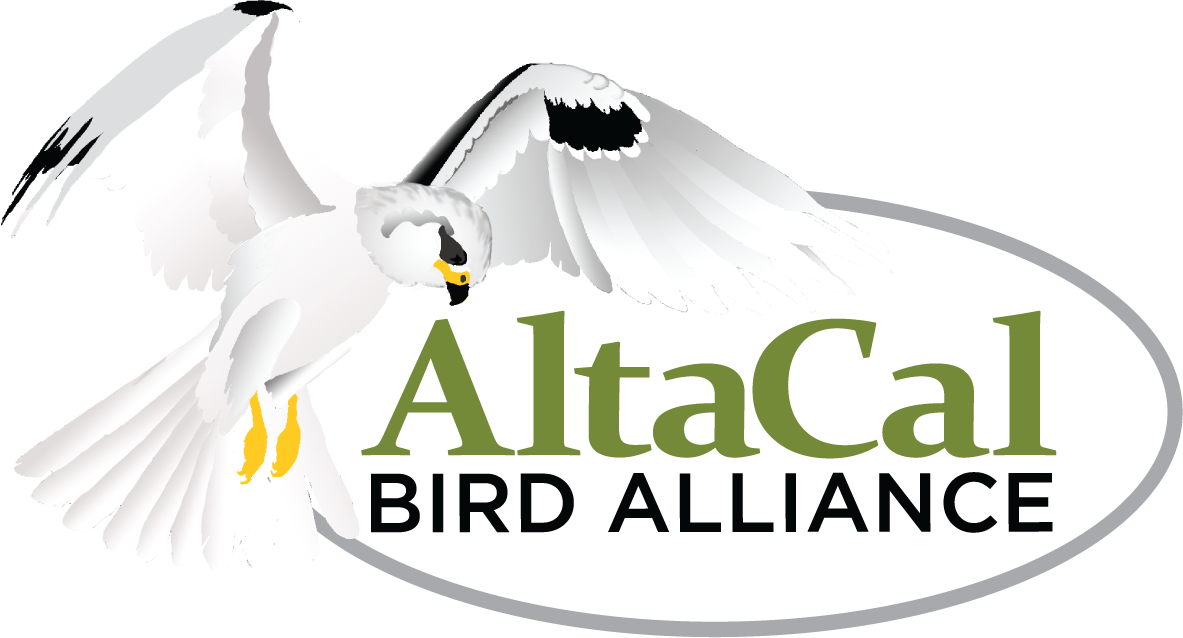SURVEYS
Every three years, a Statewide Tricolored Blackbird Survey is conducted in California. Altacal members have participated in this effort by surveying historical nesting areas in Butte, Glenn, and Tehama Counties and reporting any new colony locations. Surveys are conducted all over the state of California during three consecutive days, usually in early to mid-April. This is a huge survey effort that takes place over a very short time period, so volunteers are extremely important to conducting this survey efficiently and thoroughly.
These surveys can be critical to the success of this species because they can identify whether there are colonies that are at risk of destruction due to harvesting. The surveys also document the population of the species throughout California and help researchers track population trends.
If you would like to get involved in a triennial survey, contact Jared Geiser.
About Tricolored Blackbirds
Threatened Species
The Tricolored Blackbird was listed as a threatened species under the California Endangered Species Act on April 19, 2018, after the California Department of Fish and Wildlife reviewed a petition to list the species submitted by the Center for Biological Diversity.
The Tricolored Blackbird has been in decline since the 1930s, and one of the main reasons was found to be the decrease in nesting success (productivity) primarily caused by habitat loss due to conversion of nesting habitat to urbanization or agricultural crops or the draining of wetlands. Since the 1990s, more Tricolored Blackbirds have been forming their nesting colonies in grain crops (to be converted to silage to feed dairy cattle) grown in the San Joaquin Valley. The harvest of these crops can often decimate the breeding success of the entire colony by destroying the eggs or nestlings. Several agencies and organizations have tried to save these colonies by either persuading the farmers to wait until the young fledge to harvest the crops or purchasing the crops from the farmers in order to save the colony (Colony Protection Programs).
Causes of the Decline of the Tricolored Blackbirds
The primary reasons for the decline of tricolors are many, but include:
- habitat losses due to water diversions and draining of wetlands
- habitat losses due to conversion to agriculture
- habitat losses due to urbanization
- destruction of breeding colonies in grain fields, most often adjacent to dairies, during normal agricultural operations
More recently, and continuing to the present, three additional factors are affecting the productivity of tricolors:
- replacement of annual and perennial row crops (primarily alfalfa and sunflowers) and shrublands, which often support large insect populations and therefore provide excellent food sources, by woody perennial crops (vineyards and almond orchards), which are insect-poor and do not provide foraging opportunities; this process severely restricts essential foraging habitats surrounding potential nesting sites and may prevent the utilization of otherwise suitable nesting substrate
- predation by large numbers (i.e., 125 or more in a single colony) of cattle egrets, a voracious predator that was unknown in tricolor colonies until first observed in 2006, but that has subsequently become a serious threat to large, potentially highly productive colonies in the southern San Joaquin Valley
- harvest of the grain fields used as nesting substrate while eggs or young are still in the nests, which causes catastrophic failure of entire breeding efforts, often affecting tens of thousands of birds
Conservation Actions
Several conservation actions have been undertaken to stem the decline of the Tricolored Blackbird and to rebuild its numbers to sustain the species well into the future, including:
- annual detection and monitoring of colonies in the Central Valley, an effort providing for the detection of the largest colonies in the San Joaquin and Sacramento Valleys and near real-time monitoring of their fates
- conservation of the largest "silage colony" (i.e., nesting colony established in a triticale field in the San Joaquin Valley) through voluntary sale by the landowner and purchase by the state or federal government or nongovernmental organization, a process known as a "silage buyout"
- conservation of silage colonies by harvest delay, a procedure that involves paying a willing landowner to delay the maturation of his triticale crop by adding an extra irrigation to his irrigation schedule, with the costs associated with the extra irrigation reimbursed to the landowner; this procedure is desirable because it allows the farmer to harvest his crop while also allowing the birds to fledge their young and is quite inexpensive compared with the cost of a silage buyout
- provision of secure, attractive nesting substrate on national wildlife refuges and other protected areas, an essential component in the long-term strategy to conserve the birds; birds nesting in the protected area then forage widely around the colony, on both protected land and private property
- assisting private property owners in providing nesting substrate
- provision of "lure grains," typically rolled corn, on the periphery of colonies to provide grains for birds that would otherwise consume grains from nearby dairies
- conducting a triennial volunteer statewide survey every three years to comprehensively monitor tricolor distribution and abundance
- education and outreach through production and distribution of brochures that educate landowners and agency personnel on the status of the tricolor and efforts being made to conserve it, as well as presentations to local Audubon chapters and similar conservation organizations
- establishment of good working relationships with many landowners, who permit monitoring of colonies on their properties
- banding; over 82,000 tricolors were banded between 2007 and 2017, documenting spatial and temporal patterns of movements and providing estimates of life history parameters
- creation of a web portal providing current, documented information on tricolors and access to data and reports provided by tricolor researchers, as well as web-based data input capabilities to participants in the triennial statewide surveys

